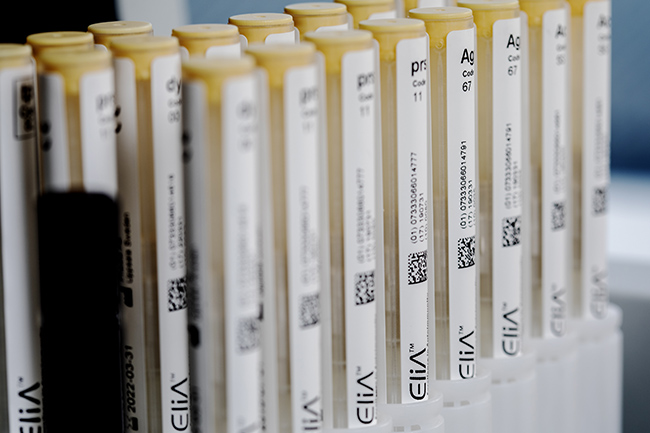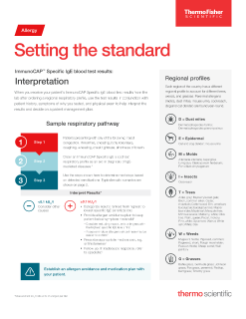ImmunoCAP Testing Interpretation Guides
Confidently diagnose and manage allergies with the support of test interpretation guides.
Access concise information on how to interpret ImmunoCAPTM Specific IgE test results as well as potential clinical implications to aid in your diagnosis and patient management plan.

How to interpret ImmunoCAP Specific IgE test results
Results indicate a patient’s level of sensitization to a specific allergen, meaning ImmunoCAP Specific IgE testing can aid in diagnosing a clinical allergy.
Results are reported in the amount of IgE antibodies for a specific allergen in kilounits of allergen per liter of blood (kUA/l).
Results ≥0.1 kUA/l indicate an allergen sensitization, which can be used to help clinically diagnose allergy as long as patient history is taken into account. ImmunoCAP tests alone cannot diagnose a clinical allergy.1
Sensitization levels vary from patient to patient, and there is no standardized numerical amount which indicates the severity of a reaction. Therefore, each patient’s personal symptom history must be considered before diagnosing.
Example:
- Patient A has a cat allergen sensitization of 10 kUA/l but does not react to cats.
Patient A is sensitized to cats but not allergic. - Patient B has a cat allergen sensitization of 5 kUA/l and experiences severe rhinitis when exposed.
Patient B may be clinically diagnosed with a cat allergy.
The role of allergen components in testing
Uncover a granular understanding of allergies to improve diagnoses.
Allergen component tests measure allergic sensitization to specific proteins and/or carbohydrates found in whole allergens, which gives you a deeper understanding of cross-reactivity, potential severity, and potential tolerance.2
Testing with allergen components can lead to optimized:2,3
- Allergy diagnosis
- Allergy management
- Insights for specialized treatment options

Respiratory allergy result interpretation guides
Regional respiratory profiles target environmental allergens specific to the region where a patient lives, allowing for more personalized testing and management.
Allergen components
Allergen component interpretation for pet allergies provide insights on cross-reactivity, the risk of asthma, and whether a patient is sensitized to a male or female dog.3
Discover the power of region-specific respiratory allergy profiles.
Food allergy result interpretation guides
Enhance food allergy patient management with guides for major food allergens, food allergen components, and more.
Allergen components
Allergen component interpretation guides for food, such as nuts, milk, eggs, and more, may provide insights on cross-reactivity, potential severity, and tolerability of baked/raw versions of foods.3
Discover more about how ImmunoCAP Specific IgE testing aids in the diagnosis of food allergy.
Additional result interpretation guides
A collection of interpretation guides for the tests that fall outside of food and respiratory.
Access interpretation guides belonging to additional assays found across our testing portfolio, such as stinging insect venom and tryptase.
Allergen components
Allergen component interpretation guides for stinging insect venom allergies, such as bees and vespids, may provide clarity on appropriate immunotherapies, cross-reactivity, and differentiation.3
Discover the complete collection of ImmunoCAP Specific IgE test interpretation guides designed to aid in diagnostic and patient management efforts.
- ImmunoCAP Specific IgE Directions for Use 2020 for the Phadia Laboratory Systems.
- Canonica, G.W., et al., A WAO - ARIA - GA(2)LEN consensus document on molecular-based allergy diagnostics. World Allergy Organ J, 2013. 6(1): p. 17.
- Matricardi, P.M., et al., EAACI Molecular Allergology User's Guide. Pediatr Allergy Immunol, 2016. 27 Suppl 23: p 77, 79-81, 97, 100, 142-143, 152, 158
















